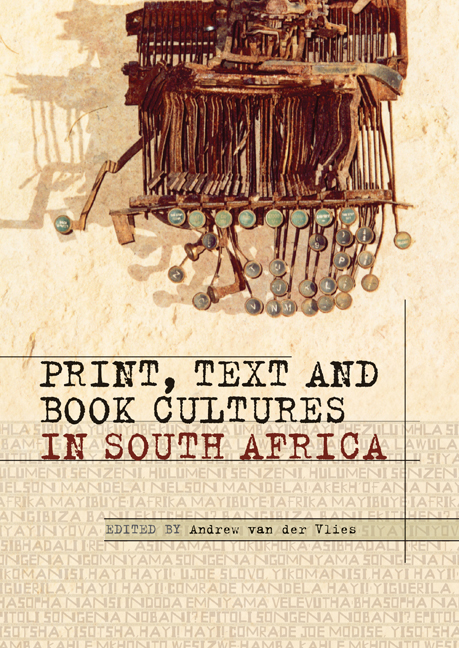Book contents
- Frontmatter
- Contents
- Acknowledgements
- Abbreviations and acronyms
- 1 Introductory
- 2 Print Cultures and Colonial Public Spheres
- 3 Local/Global: South African Writing and Global Imaginaries
- 4 Three Ways of Looking at Coetzee
- 5 Questions of the Archive and the Uses of Books
- 6 Orature, Image, Text
- 6.1 The Image of the Book in Xhosa Oral Poetry
- 6.2 Written Out, Writing In: Orature in the South African Literary|Canon
- 6.3 Not Western: Race, Reading and the South African Photocomic
- 7 Ideological Exigencies and the Fates of Books
- 8 New Directions
- Contributors
- Index
6.3 Not Western: Race, Reading and the South African Photocomic
from 6 - Orature, Image, Text
Published online by Cambridge University Press: 21 April 2018
- Frontmatter
- Contents
- Acknowledgements
- Abbreviations and acronyms
- 1 Introductory
- 2 Print Cultures and Colonial Public Spheres
- 3 Local/Global: South African Writing and Global Imaginaries
- 4 Three Ways of Looking at Coetzee
- 5 Questions of the Archive and the Uses of Books
- 6 Orature, Image, Text
- 6.1 The Image of the Book in Xhosa Oral Poetry
- 6.2 Written Out, Writing In: Orature in the South African Literary|Canon
- 6.3 Not Western: Race, Reading and the South African Photocomic
- 7 Ideological Exigencies and the Fates of Books
- 8 New Directions
- Contributors
- Index
Summary
READING PHOTOCOMICS IN SOUTH AFRICA
To be interested in reading practices in the global South often means to look beyond the strict confines of the literary, to understand how it is that other forms of textual production are used in the inscription and devolution of ideology, hegemony, subjectivity and sociality. As work in cultural studies shows, attention to popular culture reveals alternative insights about the structural formations of the society in question to those garnered from works of “high culture” such as novels and fine arts. For scholars interested in the intersection between reading and the development of ideologically suffused subjectivities in colonial and post-colonial places, the photocomic provides rich material.
This essay locates the photocomic in the historical context of apartheid South Africa, and reconsiders questions of genre and popular culture using the theoretical framework of colonial and post-colonial studies. Mirroring trends in popular genre fiction, photocomics follow narrative conventions of romances, mysteries, Westerns and crime thrillers, popularised in pulp fiction and film. Familiar characters and plot conventions from these were modulated (often by anonymous authors) to fit the photocomic form, which consisted of sequences of photos overlaid with text.
Much like comic books, they were often serialised, and many of the popular titles in South Africa, such as Great, Kid Colt, Tessa, Dr. Conrad Brand and Grensvegter, ran for upwards of 20 years. An especially popular photocomic, See: Romantic Adventures in Photos, ran for over 30 years between 1963 and 1995. While certain “universal” characteristics of the photocomic may explain its global success, the South African examples took particular forms, shaped as they were by the political, cultural and racial stipulations of a censorship board with quite different aims from those of similar regulatory bodies elsewhere. Of course, censorship extended far beyond institutional and administrative boundaries; under apartheid, white supremacist ideology inevitably shaped cultural production through both consent and coercion.
Though few scholarly studies of the genre in Africa exist, plentiful references to the “bookies” can be found on the Internet where readers of the photocomics reminisce at length about these childhood staples.
- Type
- Chapter
- Information
- Print, Text and Book Cultures in South Africa , pp. 325 - 346Publisher: Wits University PressPrint publication year: 2012



